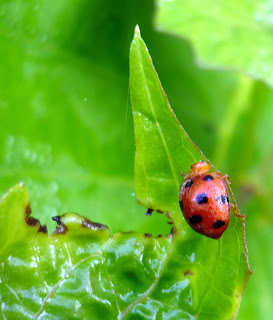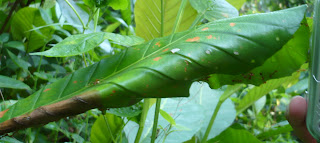Kranji Nature Trail, how many of us have heard of this place which is actually located just adjacent to Sungei Buloh Nature Reserve?
Looking at one of the two 'low-key' entry points to Kranji Nature Trail (picture below) . Who would have thought that this was a entry point to a Nature Trail. But that is the beauty of things at times. Would a Disney-like theme park entrance or such a natural walkway with trees and shrubs aligning the sides be more fitting to a nature trail like this?
I'll take the latter anytime for a nature trail.
 As the morning sun rise up in the sky, the life in the forest began their day. Here's a lady beetle or lady bird (picture below) as a first 'discovery'.
As the morning sun rise up in the sky, the life in the forest began their day. Here's a lady beetle or lady bird (picture below) as a first 'discovery'. Discovery Note:
Discovery Note:1. Commonly called as lady birds or lady bugs, but scientists prefer to call them lady beetle. As they are bettles.
2. They are generally considered useful insects as many species of lady beetles feed on pests in gardens, agricultural fields, orchards, and similar places.
3. A few species of lady beetles are pests though, but they are founding North America and
4. Some people consider seeing them or having them land on one’s body to be a sign of good luck to come, and killing them presages bad luck.
This morning, together with a group of nature lovers, we were exploring the flora and fauna along the Kranji Nature Trail. Second 'discovery' of the day were number of Simpoh Ayer plants were seen along the trail.
Flower of the Simpoh Ayer(picture below)
 Leaves of the Simpoh Ayer (picture below)
Leaves of the Simpoh Ayer (picture below) Discovery Note:
Discovery Note:1. This shrub can grow up to 7 meters tall.
2. The large robust leaves were commonly used before the days of plastic and styrofoam as disposable platters and wrappers to warp ‘tempak’ and ‘rojak’.
As we explored the Simpoh Ayer-s along the trail, we came across one of the leaves to look folded (picture below). What was going on?
 A closer look reveal the answer. Weaver ants were making a nest out of the leaf (picture below). Third 'discovery'.
A closer look reveal the answer. Weaver ants were making a nest out of the leaf (picture below). Third 'discovery'. Discovery Note:
Discovery Note:1. Weaver Ants' nests are among the most complex ants' nests.
2. These ants choose living leaves to build nests as it provides well camouflaged protection from predators and the elements.
3. The weaver ants do not have a stinger, but inflict a painful bite which is aggravated by irritating chemicals secreted from their abdomen.
Note:
For more information on Weaver Ants and how they weave their nests, click on this.
Very soon, we came across this strange lump of 'bubbles' underneath a leaf. What was this? Soon, someone provided the answer. This was done by the spittle bug (picture below). Fourth 'discovery'.
 Discovery Note:
Discovery Note:1. There are about 23,000 species of spittle bugs, but you might not have ever seen one because of the unusual way that they protect themselves.
2. They actually produce a liquid that they whip up into a mass of bubbles, and then they hide in it!
3. This mass of bubbles is called "spittle" and is where the insect gets its name.
4. The spittle that the bug creates has several jobs,
- Protection from predators. It hides inside the mass of spittle and can't be seen.
- Thermal control. The bubbles insulate it from heat and cold.
- Protection from moisture loss. Without the mass of spittle surrounding it, these insects will quickly dry out and die.
 Discovery Note (difference between a dragon fly and damselfly):
Discovery Note (difference between a dragon fly and damselfly):Dragon Fly:
1. Hind wings are usually shorter and broader than fore wings.
2. They are usually larger, strongly flying insects that can often be found flying well away from water.
3. When at rest, they hold their wings out from the body, often at right angles to it.
4. The eyes are very large and usually touch, at least at a point.
Damselfly:
1. All four wings are near enough equal in size and shape.
2. They are usually small, weakly flying insects that stay close to the water margins or water surface.
3. When at rest, most species hold their wings along the length of their abdomen.
4. The eyes are always separated, never touching.
Sixth 'discovery' was a St. Andrew Cross Spider along the side of the trail (picture below).
 Discovery Note:
Discovery Note:1. These spiders get their name for the way their hold their eight legs in pairs to form an X shape.
2. This X is called the St. Andrew's cross because it is believed that the saint was martyred on a cross of this shape.
3. Besides their standard orb-web, these spiders also build additional white opaque zig zag lines on their webs, which are called stabilimentum.
Note:
For more information on the St. Andrew Cross Spider, click here.
Walking on, an interesting plant attracted me due to the shape of its leaves. Luan Keng pointed out that this is the Sea Holly (picture below). Oh, seventh 'discovery'.
 Discovery Note:
Discovery Note:1. These plants have no relation whatsoever with the Christmas Holly, although they appear similar.
2. Sea Holly grows on mud near the hide tide mark or along river banks. But it grows especially well in areas with more freshwater input.
3. Unlike some mangrove plants, Sea Holly does not exclude salt at the root level. In fact, their sap is salty and excess salt is secreted through the leaves, to be removed by rain or wind.
4. Sometimes, the excess salt can be seen as a white crystalline layer on the upper surface on their leaves.
Note:
More information on the Sea Holly can be found here.
As we made our way across the bridge which links the trail to Sungei Buloh Nature Reserve. I took this photo (picture below) to document the mangrove shore line and the misty/hazy morning. Is the haze coming back again?
 Very soon, we reached Sungei Buloh Nature Reserve for our well-deserved water and toilet break. And hearing that the toilet at the reserve had just been renovated. I was curious to find out how it looked like now. And oh my, it's so interesting now. Look at the three photos that follows to understand why...
Very soon, we reached Sungei Buloh Nature Reserve for our well-deserved water and toilet break. And hearing that the toilet at the reserve had just been renovated. I was curious to find out how it looked like now. And oh my, it's so interesting now. Look at the three photos that follows to understand why...

 Looking at our watches, we figured that we still have one more hour of time before the planned time to go for lunch. So we decided to go for some bird watching at the reserve. And here's one find. The milky stork, eighth 'discovery'!
Looking at our watches, we figured that we still have one more hour of time before the planned time to go for lunch. So we decided to go for some bird watching at the reserve. And here's one find. The milky stork, eighth 'discovery'! Discovery Note:
Discovery Note:1. They are white storks with thick, yellowish bill and blackish flight feathers.
2. They can grow to a length of 97 cm.
3. Both sexes look similar.
4. They have sensitive areas on their bills that can feel prey brushing against it.
5. Due to human disturbance of nesting colonies, habitat loss and destruction of mangroves, poaching, and rice- and fish-farming, the milky stork is an endangered species.
So with this sighting, all of us left the area satisfied with our finds and hungry in our stomachs. =).
But, no matter what, thanks to Luan Keng for planning the walk and everyone who came and helped me to ID the flora and fauna i didn't know.
Side Note:
Discoverers may visit these blogs to read more about what was seen on this trip,
1. Mountain and Cloud's Blog
2. Manta's Blog
1 comment:
Hi July, regarding the Simpoh Ayer leaves. Remember when we were young, most hawkers used the leaves as a packaging material for rojak, fried carrot cakes etc. Using this type of leaves add a special aroma to the food which we cannot find today in paper/plastic packaging.
The most recent event that we used this leave again, was in our reservist, we were out in the fields and some of us forgot their mess tins. So these leaves came to the rescue serving as dish. But in the army, never use this broad leaves for camouflage purpose.
Mountain and Sea
Post a Comment